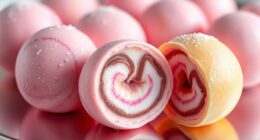Frozen yogurt is primarily made from yogurt, often whole-milk or Greek, which gives it a creamy texture. It also contains milk solids and milk fat for creaminess. Sweeteners like sugar or honey help balance the flavor and prevent ice crystals. Live yogurt cultures provide probiotics, while fruit and vanilla flavorings add variety. Some brands may include stabilizers for consistency. Frozen yogurt is generally lower in calories than ice cream, making it a nutritious option. If you are interested in making it at home or trying different flavors, there is much more to explore!
Key Takeaways
- The primary ingredient in frozen yogurt is yogurt, typically whole-milk or Greek, providing a creamy texture.
- Sweeteners like sugar or honey are added to balance flavor and prevent ice crystal formation.
- Yogurt cultures, such as Lactobacillus bulgaricus and Streptococcus thermophilus, are included for fermentation.
- Milk solids and milk fat contribute to the creaminess, with fat content ranging from 0.55% to 6%.
Key Ingredients in Frozen Yogurt
Frozen yogurt's key ingredients include milk solids, sweeteners, milk fat, yogurt cultures, and flavorings that work together to create its creamy texture and delicious taste.
The milk fat in frozen yogurt typically ranges from 0.55% to 6%, adding richness and enhancing its smoothness. Yogurt cultures, such as Lactobacillus bulgaricus and Streptococcus thermophilus, are crucial for the fermentation process. These cultures not only contribute to the tangy flavor but also help in the development of a creamy consistency.
Sugar or alternative sweeteners play an important role in balancing the taste and preventing large ice crystals from forming. This guarantees that each scoop remains smooth and enjoyable. The combination of sweeteners and milk fat allows frozen yogurt to maintain a delightful mouthfeel while satisfying your sweet cravings.
Additionally, flavorings like fruits, cocoa, and vanilla can be added to create a diverse range of flavors, catering to your personal preferences. Each ingredient works in harmony to provide the perfect frozen yogurt experience, making it a popular treat for many.
Production Process Overview

The production of frozen yogurt begins with pasteurizing milk to eliminate harmful bacteria, setting the stage for a creamy and safe treat. After heating the pasteurized milk to around 79°C, it's cooled to 4°C. You then add live yogurt cultures, primarily Lactobacillus bulgaricus and Streptococcus thermophilus, at 32°C and let it age for about four hours. This step is essential as it kick-starts fermentation.
Next, the mixture combines with milk solids, sweeteners, and stabilizers, enhancing both texture and sweetness. The initial freezing occurs in a heat exchanger, where homogenization and air incorporation contribute to a smoother texture. The mixture is churned until it reaches a thick, soft-serve consistency.
Finally, the frozen yogurt is packed into containers and must be frozen for at least six hours to achieve a scoopable state. Here's a quick overview of the production steps:
| Step | Description |
|---|---|
| Pasteurization | Heating milk to eliminate bacteria |
| Adding Cultures | Introducing yogurt cultures for fermentation |
| Initial Freezing | Combining with other ingredients and freezing the mix |
This process guarantees you enjoy a delicious and creamy treat!
Differences From Ice Cream

When you compare frozen yogurt to ice cream, you'll notice some key ingredient differences right away.
Frozen yogurt has lower fat content and a tangy flavor due to its yogurt base, while ice cream is creamier and generally sweeter.
These variations also affect their texture and sugar content, creating distinct experiences for your taste buds.
Key Ingredient Differences
Cultured milk in frozen yogurt sets it apart from ice cream, which relies on cream, resulting in notable differences in fat content and texture.
You'll find that frozen yogurt is typically lower in fat, containing about 3-6% milk fat, while ice cream must have at least 10% milk fat. This difference means that frozen yogurt often has a higher water content, leading to the formation of large ice crystals, which can affect the overall mouthfeel.
Additionally, frozen yogurt usually contains more added sugar to balance the tangy flavor from the yogurt mixture. While this makes it taste sweet, it can mean that some frozen yogurts have equal or even higher sugar levels compared to ice cream.
One significant bonus of frozen yogurt is the presence of live bacterial cultures, which can provide health benefits that ice cream lacks due to its higher heat processing.
Texture and Consistency
Frozen yogurt's higher water content leads to a less creamy texture than ice cream, often resulting in the formation of ice crystals that can affect mouthfeel. The fat content in frozen yogurt typically ranges from 0.55% to 6%, while ice cream contains at least 10% milk fat, contributing to its richer, creamier texture. If you're after a creamier frozen yogurt, consider options that use whole-milk yogurt or added cream, which can enhance the overall texture.
The churning process also plays a role in texture. Frozen yogurt is churned differently, incorporating air during freezing, resulting in a smoother feel but generally less fluffiness than ice cream. Additionally, the presence of live bacterial cultures in frozen yogurt adds a unique tanginess that contrasts with ice cream's sweeter profile.
When frozen yogurt is poorly made, it can suffer from the formation of large ice crystals, which further detracts from its texture. To improve the experience, look for frozen yogurt with lower water content and higher fat content, as well as those sweetened with granulated sugar to balance the flavor. These factors considerably influence the overall texture and enjoyment of frozen yogurt.
Sugar Content Comparison
The difference in sugar content between frozen yogurt and ice cream can greatly impact their taste and texture, often surprising those who assume frozen yogurt is the healthier option.
While frozen yogurt often boasts lower fat content, it can sometimes contain equal or even higher amounts of sugar than ice cream. The sugar is vital, as it prevents the formation of large ice crystals during freezing, guaranteeing a smooth consistency that many people love.
You might find that some frozen yogurt varieties have sugar levels that rival those of ice cream, making it important to check labels for accurate nutritional profiles. Many brands market frozen yogurt as a healthier choice, but this can be misleading.
With sugar content varying widely by brand and flavor, it's essential to enjoy frozen yogurt in moderation. Balancing your sweet treat cravings with awareness of sugar levels can help you make informed choices.
Health Benefits and Nutritional Value

Enjoying frozen yogurt not only satisfies your sweet tooth but also offers a healthier alternative to traditional ice cream, thanks to its lower fat content and nutrient-rich yogurt base. When you choose frozen yogurt, you're indulging in a treat that typically has fewer calories—around 146.5 kcal per serving—compared to ice cream, making it a lower-calorie dessert option.
One of the standout features of frozen yogurt is its nutritional value. Each serving can provide essential nutrients like calcium and protein, which are important for bone health and muscle maintenance. Additionally, many frozen yogurts contain probiotics, beneficial bacteria that may support your digestive health. However, keep in mind that the amount of probiotics can vary depending on the production methods used.
You'll also find that frozen yogurt often has lower sugar content than traditional ice cream, though this can depend on the specific brand and flavor you choose. Always check the labels to make informed decisions about your dessert.
Popular Flavor Variations

Exploring the world of frozen yogurt reveals a delightful array of popular flavor variations that cater to every palate.
You'll find classic options like vanilla, chocolate, and strawberry that never go out of style. If you're feeling adventurous, try more unique flavors such as green tea, cake batter, or salted caramel, which can truly elevate your dessert experience.
Many frozen yogurt shops also roll out seasonal flavors to keep things exciting. Think pumpkin spice in the fall or invigorating peppermint during the winter holidays. If you're a fan of tangy treats, tart frozen yogurt is a must-try, especially when topped with your favorite fruits or candies.
For those who are health-conscious, there are plenty of options available, including sugar-free and low-fat frozen yogurt. Flavors like coconut or raspberry allow you to indulge without the guilt.
You can mix and match your toppings to create a personalized treat that satisfies your cravings while staying aligned with your dietary preferences. With such a variety of frozen yogurt flavors and toppings to choose from, there's something for everyone to enjoy!
Tips for Making at Home

Making frozen yogurt at home can be a fun and rewarding experience, especially when you customize it to your taste.
Start with whole-milk Greek yogurt for a rich texture and that signature tangy flavor. This yogurt contains live cultures that not only add probiotics but enhance the overall taste.
To sweeten your homemade frozen yogurt, incorporate sweeteners like sugar or honey—aim for at least 3/4 cup of sugar per quart of yogurt. This will help minimize ice crystals and boost sweetness.
If you want an even creamier consistency, consider adding cream or mascarpone; this can greatly improve the richness and smoothness of your mixture.
When it comes to freezing, use shallow, wide containers. This speeds up the freezing process, making your frozen yogurt easier to scoop once set.
Before serving, let your frozen yogurt sit at room temperature for about 20-30 minutes. This step enhances scoopability and improves the overall texture, making your treat even more enjoyable.
With these tips, you'll create the perfect homemade frozen yogurt tailored just for you!
Frequently Asked Questions
What Is in Frozen Yogurt Ingredients?
When you enjoy frozen yogurt, you're tasting a mix of milk solids, sweeteners, milk fat, yogurt cultures, and flavorings. These ingredients create that deliciously creamy texture and tangy flavor you love so much!
Is Frozen Yogurt Healthier Than Ice Cream?
Did you know frozen yogurt can have equal or higher sugar levels than ice cream? While it's lower in fat, you should check labels to determine if it's genuinely a healthier option for you.
What Is the Chemical Composition of Frozen Yogurt?
When you explore frozen yogurt's chemical composition, you'll find milk solids, fats, sweeteners, and stabilizers. These components work together to create the smooth texture and tangy flavor you enjoy in every delicious bite.
What Makes Frozen Yogurt Different From Yogurt?
You might think frozen yogurt's just a cold version of yogurt, but it's different. Its higher sugar content, lighter texture, and added stabilizers create a uniquely sweet, creamy treat that sets it apart from regular yogurt.
What Are the Ingredients in Frozen Yogurt That Make It Nutritious?
When looking at frozen yogurt nutrition facts, it’s important to consider the key ingredients that make it nutritious. With live and active cultures, protein, calcium, and low fat content, frozen yogurt can be a healthier alternative to traditional ice cream. These components contribute to its overall nutritional value.
Conclusion
To sum up, frozen yogurt offers a delicious and healthier alternative to traditional ice cream, as it typically contains about 30% fewer calories.
With its creamy texture and variety of flavors, it's no wonder that frozen yogurt shops have surged in popularity.
Whether you're enjoying it at a local shop or making it at home, you can savor a treat that not only satisfies your sweet tooth but also provides some nutritional benefits.
Enjoy your next scoop!









